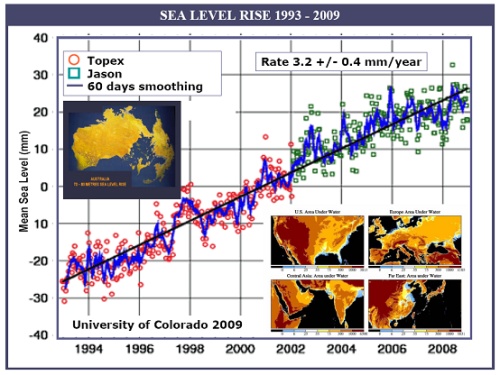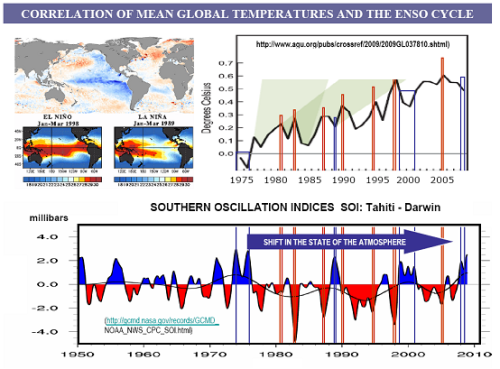“We're simply talking about the very life support system of this planet.” (Joachim Schellnhuber, Director, Potsdam Climate Impacts Institute, advisor to the German government).
The release of more than 320 billion tons of carbon (GtC) from buried early biospheres, adding more than one half of the original carbon inventory of the atmosphere (~590 GtC) to the atmosphere-ocean system, has triggered a fundamental shift in the state of the atmosphere at a rate of 2ppm CO2/year, a pace unprecedented in the geological record with the exception of the effects of CO2 released from craters excavated by large asteroid impacts.
Recent paleoclimate studies, using multiple proxies (soil carbonate δ13C, boron/calcium, stomata leaf pores), indicate that the current CO2 level of 388ppm and CO2-equivalent level of 460ppm (which includes the methane factor), commits warming above pre-industrial levels to 3 to 4 degrees C in the tropics and 10 degrees C in polar regions, leading to an ice-free Earth.
Advertisement
Such conditions existed in the early Pliocene (5.2 Ma) and mid-Pliocene (2.8 Ma) Pliocene, about the time Australopithecine bipeds were emerging from tropical forests. Pliocene climates changed gradually and pre-historic humans responded through migration. There is nowhere the 6.5 billion of contemporary humans can go, not even the barren planets into the study of which space agencies have been pouring more funding than governments allocated for environmental mitigation to date.
It appears difficult to explain to the public and politicians that, at 460ppm CO2-equivalent, the climate is tracking close to the upper stability limit of the Antarctic ice sheet, defined at approximately 500ppm. Once transcended, mitigation measures would hardly be able to re-form the cryosphere, which serves as the Earth’s thermostat, from which cold ocean and wind current emanate - keeping lower latitudes cool. Once the ice melts the atmosphere-ocean system shifts to greenhouse Earth conditions such as existed about 15 million years ago (Ma) (mid-Miocene), before 40 Ma (Eocene), and much of the Cretaceous (141 - 65 Ma), when only small burrowing mammals could live on land.
About 2.8 Ma, the mid-Pliocene, temperatures rose by at least 3 degrees C above pre-industrial and sea levels rose by 25+/-12 meters. About 15 million years ago the rise of CO2 to near~500ppm resulted in global temperatures about 4 degrees C above pre-industrial level and sea level by about 40 metres. Since the early 20th century the rate of sea level rise increased from about 1mm/year to about 3.5 mm/year (1993 - 2009 mean rate 3.2+/-0.4mm/year (Figure 1).

Figure 1. Sea level changes 1993 - 2009 scanned by the Topex and Jason satellites. University of Colorado, 2009.
The world is in a lag period, when the consequences of human greenhouse gas emissions and land clearing are increasingly manifest, including atmospheric energy levels which drive hurricanes and is shifting climate zones towards the poles, with consequent desertification of temperate zones, i.e. southern Europe, southern Australia, southern Africa. The desiccated forests become prey to firestorms, such as in Victoria and California.
Advertisement

Figure 2. Mean global temperature trend 1975 - 2009 [7] and the ENSO cycle, representing the superposition of the el Niño - la Niña cycles on the global warming trend.
Global warming is modulated by the ENSO cycle, including relatively cool la Niña phases (Figure 2). Studiously ignorant climate change deniers, who would like to call themselves “sceptics”, use these cycles to claim “global cooling”. In contravention of basic laws of thermodynamics (Stefan-Boltzmann law, Kirchoff law) which underlie the infrared absorption/emission resonance effect of greenhouse molecules, they invoke the role of short-lived (nine days average atmospheric residence) water vapour but neglect the long-term effects (centuries to millennia) of the well-mixed CO2 and nitric oxides. The increased frequency of the el Niño is tracking towards conditions of permanent el Niño, free from the effects of polar-derived currents (Humboldt Current, California Current). Such conditions existed about 2.8 Ma ago (Figure 3).
Discuss in our Forums
See what other readers are saying about this article!
Click here to read & post comments.
40 posts so far.